
Hylaeus is a large and diverse cosmopolitan genus within the bee family Colletidae. This genus is also known as the yellow-faced bees or masked bees. This genus is the only truly globally distributed colletid, occurring on all continents except Antarctica.

Habropoda laboriosa, the southeastern blueberry bee, is a bee in the family Apidae. It is native to the eastern United States. It is regarded as the most efficient pollinator of southern rabbiteye blueberries, because the flowers require buzz pollination, and H. laboriosa is one of the few bees that exhibit this behavior. It is active for only a few weeks of the year, while the blueberries are in flower during early spring, when the temperature is warm and humid. H. laboriosa are solitary bees that live alone but nest in close proximity with other nests of their species. They have similar features to bumble bees, but they are smaller in size compared to them. H. laboriosa are arthropods so they have segmented bodies that are composed of the head, thorax, and abdomen.

Xylocopa virginica, sometimes referred to as the eastern carpenter bee, extends through the eastern United States and into Canada. They are sympatric with Xylocopa micans in much of southeastern United States. They nest in various types of wood and eat pollen and nectar. In X. virginica, dominant females do not focus solely on egg-laying, as in other bee species considered to have "queens". Instead, dominant X. virginica females are responsible for a full gamut of activities including reproduction, foraging, and nest construction, whereas subordinate bees may engage in little activity outside of guarding the nest.

The Leucospidae are a specialized group of wasps within the superfamily Chalcidoidea, that are ectoparasitoids of aculeate wasps or bees. They are typically mimics of bees or stinging wasps, often black with yellow, red, or white markings, sometimes metallic, with a robust mesosoma and very strong sculpturing. The hind femora are often greatly enlarged, with a row of teeth or serrations along the lower margin as in Chalcididae. The wing has a longitudinal fold. The female ovipositor is sometimes short, but if not, it is recurved and lies along the dorsal side of the metasoma, a unique feature. The males are also unusual, in the fusion of many of the metasomal segments to form a capsule-like "carapace".
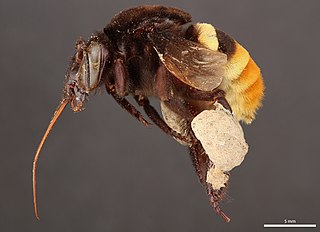
Eulaema is a genus of large-bodied euglossine bees that occur primarily in the Neotropics. They are robust brown or black bees, hairy or velvety, and often striped with yellow or orange, typically resembling bumblebees. They lack metallic coloration as occurs in the related genus Eufriesea.
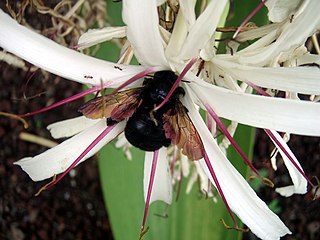
Xylocopa sonorina, the valley carpenter bee or Hawaiian carpenter bee, is a species of carpenter bee found from western Texas to northern California, and the eastern Pacific islands. Females are black while males are golden-brown with green eyes.

The California carpenter bee or Western carpenter bee, Xylocopa californica, is a species of carpenter bee in the order Hymenoptera, and it is native to western North America.

Exomalopsis is a genus of bees in the family Apidae. They occur in the Western Hemisphere.
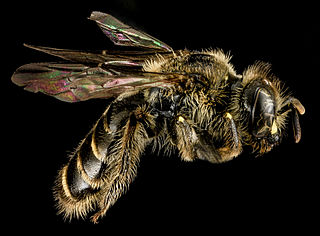
Calliopsis is a genus of panurgine bees in the family Andrenidae. There are over 80 described species distributed throughout the western hemisphere.
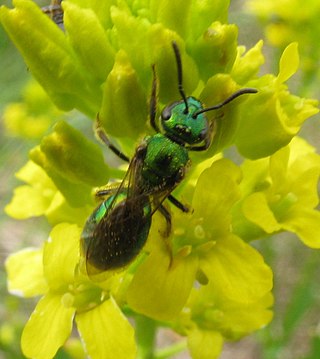
Augochlorella is a genus in the bee family Halictidae, commonly called sweat bees. They display metallic coloration, ranging from reddish to gold to bluish green, as is typical for other genera in the tribe Augochlorini.

Coelioxys banksi is a species of leafcutter bees in the family Megachilidae. It is a parasite of Megachile relativa nests.
Habropoda depressa is a species of anthophorine bee in the family Apidae. It is found in North America. It nests in hard-packed soils.
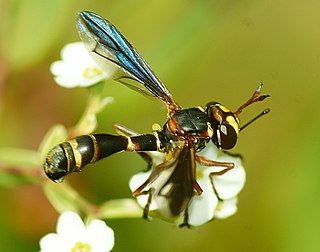
Physocephala marginata is a species of thick-headed fly in the family Conopidae. It is a parasite of Anthophora abrupta bees, although pupation occurs only after death of the host bee.
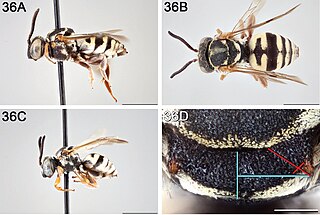
Epeolus compactus is a species of cuckoo bee in the family Apidae. It is found in the United States and Mexico. It is a parasite of Colletes kincaidii, with females laying eggs in the host species' nest.
Neolarra californica is a species of cuckoo bee in the family Apidae. It is found in the United States and Mexico. The species can be found in nests of Perdita difficilis bees.

Ceratina calcarata, the spurred ceratina, is a species of small carpenter bee in the family Apidae. It is found in eastern North America. This species ranges from Georgia, USA north to Ontario, Canada and east to Nova Scotia, Canada. This bee is a common generalist, native pollinator, it pollinates plants like watermelon and cucumber very effectively. C. calcarata adds to the productivity of a wide range of ecological and agricultural systems due to its wide range and abundance. This small bee is becoming a model organism in the scientific research of social evolution. C. calcarata is the first subsocial bee species to have its genome published, allowing researchers to investigate the evolutionary origins of social behaviour.

Andrena prunorum, otherwise known as the purple miner bee, is a species of solitary bees in the family Andrenidae. It is commonly found in the continental United States as well as much of North and Central America. Andrena prunorum is a spring-flying, ground-nesting bee that serves as a ubiquitous generalist in ecological settings. Both males and females live as prepupae in the winter in which they mate, and the females seek new sites for ground burrows. From there, they construct small cells surrounding a ball of pollen combined with nectar to nourish a laid egg before each cell is sealed, and the cycle begins anew. A. prunorum generally prefer the pollen derived from Rosaceae plants but will pollinate fruit trees if given the opportunity.

Anthophora abrupta is a species of anthophorine bee in the family Apidae. It is found in North America. Females only mate once, while males can mate multiple times. This bee nests gregariously - when one female starts building a nest, others are attracted by her movements and pheromones.

Megalopta is a widespread neotropical genus of bees in the tribe Augochlorini in family Halictidae, known as the sweat bees. They are the largest of the five nocturnal genera in Augochlorini. Most have pale integumentary pigmentation, and all have large ocelli, most likely a feature of their nocturnal behavior. They live in tropical Central America and the entirety of South America. The subgenus Noctoraptor is cleptoparasitic. They are not known from the fossil record.

Meloetyphlus fuscatus, the blind blister beetle, is a species of blister beetle in the family Meloidae found in Central and South America. They are kleptoparasites of orchid bees and are entirely blind as adults. Unique among meloids, females do not lay their eggs near flowers, but rather within their hosts' nests.


















